On View
Did Forensic Architecture Prove That Police Unlawfully Killed a Man? The Collective’s New Work Breaks Down a Tragedy, Frame by Frame
The project investigates the case of Harith Augustus.
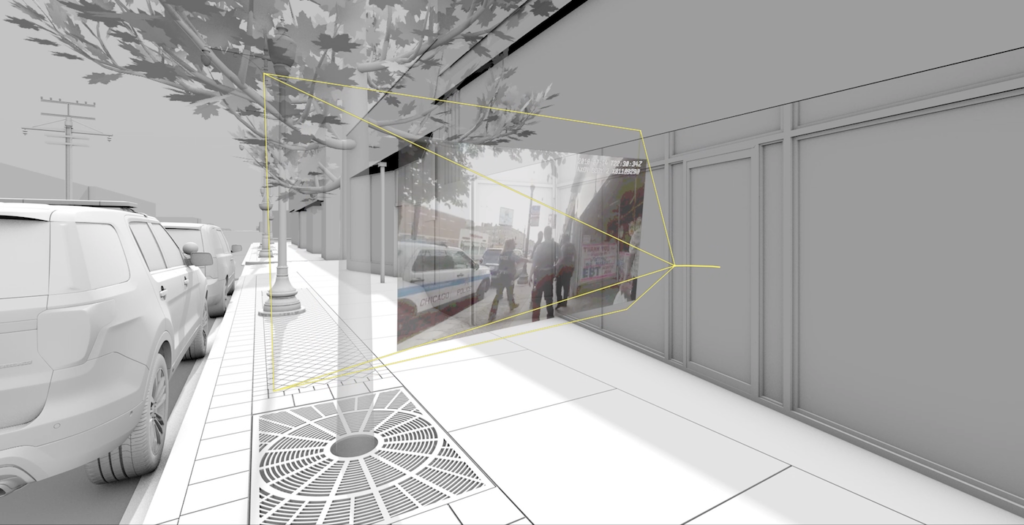
The project investigates the case of Harith Augustus.

Sarah Cascone

On July 14, 2018, Harith Augustus, a 37-year-old barber, was walking down the street in Chicago’s South Side when the five police officers stopped him for carrying a gun. Within seconds, officer Dillan Halley shot Augustus five times—four times in quick succession and once after a short pause, when Augustus was already on the ground—and killed him.
Soon after, the investigative collective Forensic Architecture and the Invisible Institute, a non-profit platform for human-rights journalism, teamed up to look at how such a tragedy takes place by analyzing it from every angle.
The resulting research and video work is now part of the Chicago Architecture Biennial. “It’s one of the closest analyses of any police shooting ever done,” Israeli architect Eyal Weizman, Forensic Architecture’s founder and director, told artnet News. “We’ve modeled the actions of each actor [the police and the man who was killed] frame by frame from footage from four different cameras.”
Since its founding in 2010, Forensic Architecture has worked to expose human-rights violations through 3-D animations, interactive maps, and models that help viewers understand complex and controversial events as they unfolded. The Invisible Institute, which Kalven co-founded in 2000, is versed in more traditional reporting skills, such as sourcing government documents, filing Freedom of Information Act requests, and interviewing witnesses.
Forensic Architecture is also featured in the current Whitney Biennial. The collective was among the participants that asked that their work be withdrawn from the exhibition in protest of the museum board’s vice chair, Warren Kanders, who was targeted by activists for owning the tear-gas manufacturer Safariland, and who later resigned.
Forensic Architecture’s work in the biennial, a video titled Triple Chaser, takes Kanders’s company as its subject by investigating businesses that have links to Safariland and have committed human-rights violations around the world.
Forensic Architecture also earned a surprise nomination for the 2018 Turner Prize for its work mapping London’s devastating Grenfell Tower fire of 2017.
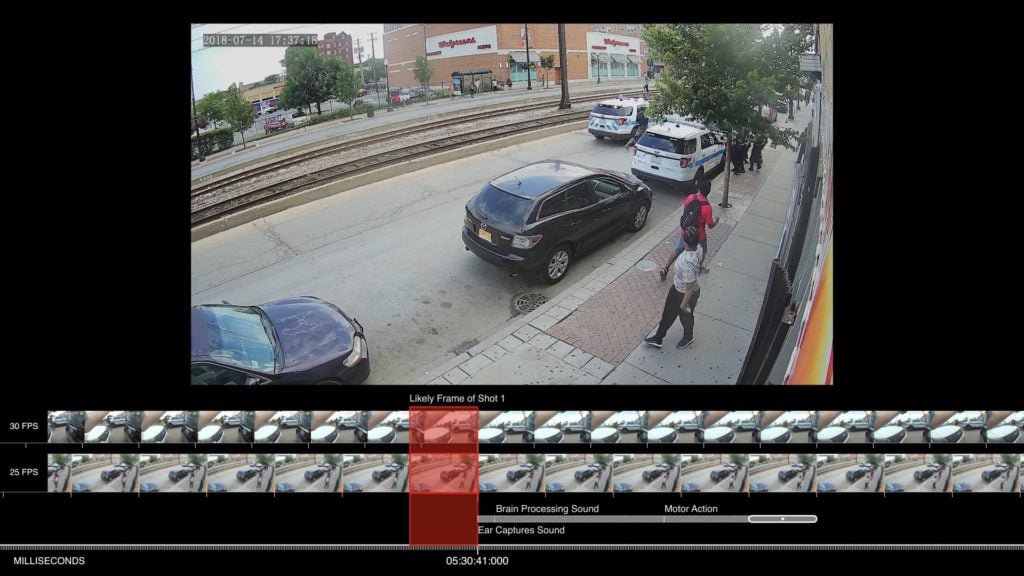
Forensic Architecture and the Invisible Institute, still of Six Durations of a Split Second: The Killing of Harith Augustus (2019). Photo courtesy of Forensic Architecture and the Invisible Institute.
The people of Chicago have responded with suspicion and anger to the killing of Augustus, who is far from the first black man to be gunned down by police in recent years. Within 24 hours, the police publicized a video from officer Halley’s body cam, which “speaks for itself,” police superintendent Eddie Johnson said. “Decisions to use lethal force are made in a split second.”
Forensic Architecture disagreed. “It is much more complicated than that,” Weizman said. The video was released under the title “Aggravated Assault to a Police Officer,” zooming in and pausing the frame to show Augustus’s holstered gun. It framed the encounter from the perspective of the officer, casting Augustus in the role of suspect and therefore helping shape the narrative most favorable to police.
Following a Freedom of Information Act lawsuit, filed by local activist Will Calloway, police identified and released an additional 18 video sources capturing the event. By analyzing all the footage, Forensic Architecture was able create an animated 3-D model of the fatal encounter.
“We came up with the idea of interrogating the notion of the split second, which is always invoked by the military and the police in instances of state violence against a civilian,” Kalven said. The resulting work, titled Six Durations of a Split Second: The Killing of Harith Augustus, includes six videos that each consider the events in a different time scale, from milliseconds, to seconds, minutes, hours, days, and years.
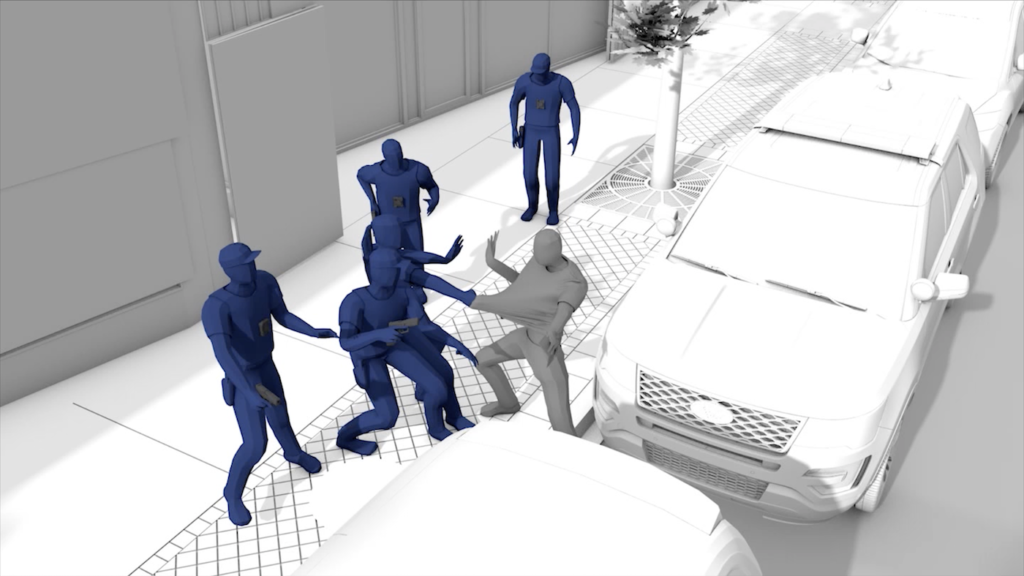
Forensic Architecture and the Invisible Institute, still from Six Durations of a Split Second: The Killing of Harith Augustus (2019). Courtesy of Forensic Architecture and the Invisible Institute.
Not shown in the original video released by the police is the beginning of the encounter. As Augustus was walking down the street, police noticed that it appeared he was carrying a gun under his shirt (a fact that would not have necessarily been illegal in Illinois, which grants concealed-carry permits).
One officer made an investigative stop, asking Augustus if he had a gun license. As Augustus took the card out of his wallet, another officer approached from behind, without saying anything, and tried to handcuff him. Alarmed, Augustus tried to flee, his shirt flying up to reveal the gun as he stumbled into the street.
As he turned, Augustus’s hand went toward his waistband, possibly to pull up his sagging pants or possibly to reach for the gun. Only Halley, one of five officers on the scene, made the decision to shoot. Immediately after, he radioed in, saying “Police shot. Shots fired at the police,” although Augustus’s gun had remained holstered.
“We clearly show the story of the split second,” Weizman said. “The attempt to arrest Augustus was undertaken wrongfully, without any warning, coming from behind. It provoked him and put the whole incident in motion—we show that the police created the incident they were responding to.”
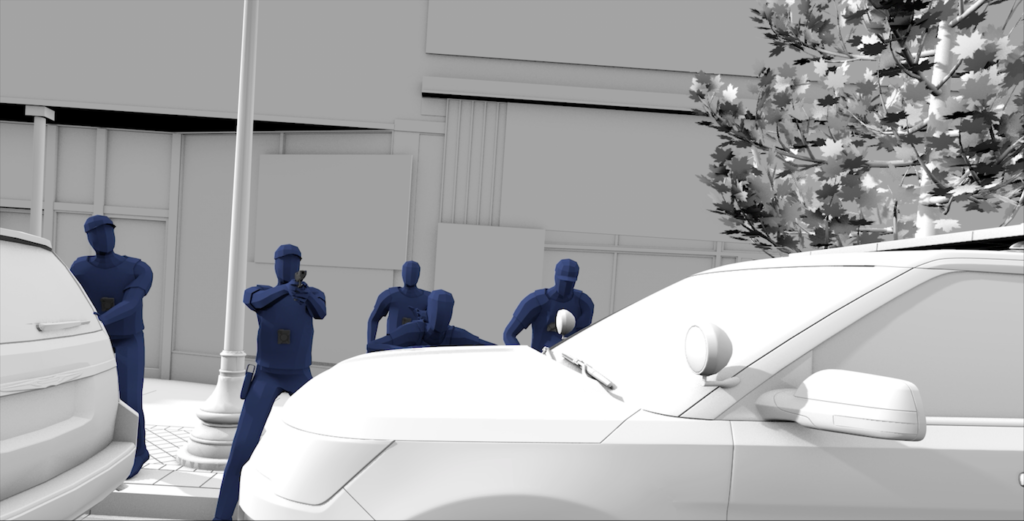
Forensic Architecture and the Invisible Institute, still of Six Durations of a Split Second: The Killing of Harith Augustus (2019), recreating Augustus’s point of view right before he was shot. Photo courtesy of Forensic Architecture and the Invisible Institute.
And just how long was that “split second” that led Halley to raise his gun and pull the trigger? The new research concludes that Halley must have decided to shoot moments before Augustus’s hand brushed against the holster of his gun, and that he took two steps before firing again, after Augustus was on the ground.
“We believe it was not a lawful killing,” Weizman said.
As afternoon turned into evening, footage captured by cell phone shows the police leaving the crime scene to confront a crowd that had gathered across the street, beating them with batons and arresting four people. Among the crowd was Trina Reynolds-Tyler, an Invisible Institute researcher, who speaks on camera in one of the videos about the harrowing experience.
“The community is just watching in mourning and the police are charging at them with batons. It’s a level of violence that was completely disproportionate and unmerited,” Weizman said.
None of the videos are actually on view in the biennial, which instead presents a stark, black-and-white room offering a written description of the project and the decision to remove the visual elements of the piece. Should visitors want to engage further, they can watch the video online, or at the Invisible Institute’s headquarters in Chicago, not far from the scene of the shooting.
“It began to feel more and more problematic to show this incredibly sustained, multi-perspective investigation of the killing of yet another black man by white police,” Kalven explained. “On the one hand, it’s imperative to share this investigative reporting. On the other, there are real implications to looking, and it should be a choice to look.”
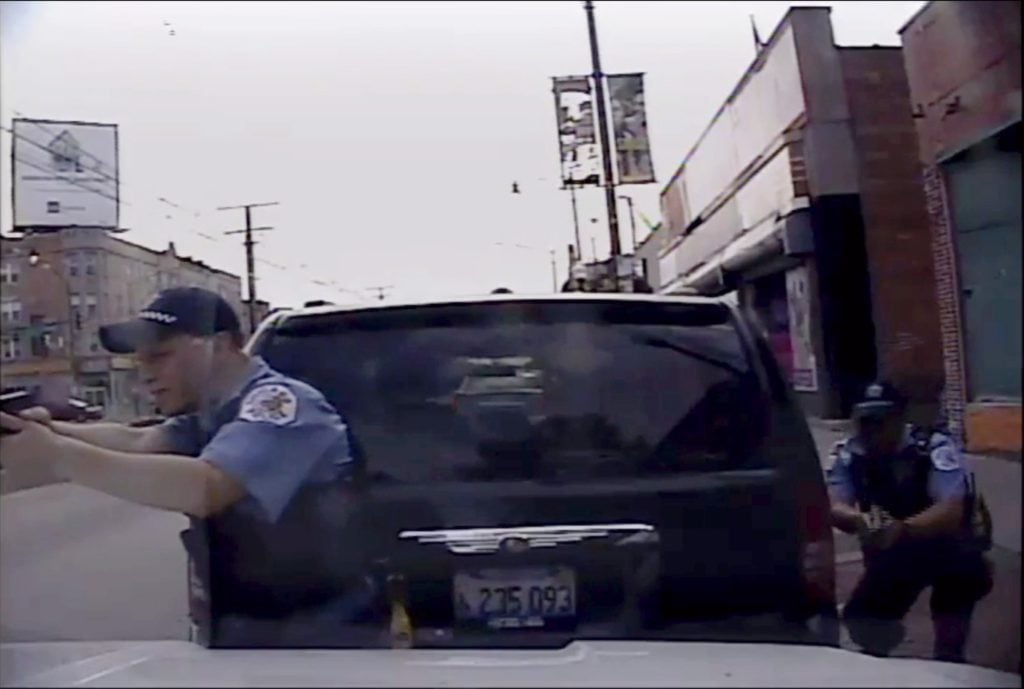
A still from dashcam footage released just three weeks ago showing officers in pursuit of, and subsequently shooting, Harith Augustus. Photo courtesy of Forensic Architecture and the Invisible Institute.
Even though much of the work is on view now, the project is still ongoing. Despite court orders, researchers discovered that three additional video sources that documented the event had not been made public. Just three weeks ago, the police finally released dash cam footage showing Halley shooting Augustus as he fled. “We got the video literally as we were finishing editing the file,” Weizman said.
Calloway, the local activist, has filed a followup in his lawsuit asking that the police be held in contempt of court. The footage from two additional CCTV cameras with a clear overhead view of the shooting have yet to be released.
Official investigations into Augustus’s death are still ongoing, including a wrongful death lawsuit filed by his family against the police. “The Citizen’s Office of Police Accountability is investigating and it hasn’t released its findings yet,” Kalven said. “It’s unlikely that there will be a criminal proceeding against the officer, but we’ll see.”
Ultimately, Weizman hopes that Forensic Architecture’s techniques will be used more widely and find application in similar cases.
“If any of the work that we’ve done is helpful in pursuing legal remedies we certainly want to help with that in any way we can,” Kalven added. “But all the conditions that contributed to this completely unnecessary death still exist right now, and make it all but inevitable that there will be more avoidable deaths of this nature. We just want people to pause and take in this knowledge with the sense that you incur responsibility when you know these things.”
The Chicago Architecture Biennial is on view at 78 East Washington Street, Chicago, Illinois, September 19, 2019–January 5, 2020. Six Durations of a Split Second: The Killing of Harith Augustus is on view at the Invisible Institute, at the Experimental Station 6100 South Blackstone, Chicago, Illinois, September 19, 2019–January 5, 2020.